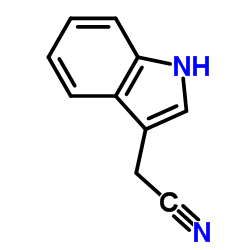3-Indoleacetonitrile

3-Indoleacetonitrile structure
|
Common Name | 3-Indoleacetonitrile | ||
|---|---|---|---|---|
| CAS Number | 771-51-7 | Molecular Weight | 156.184 | |
| Density | 1.2±0.1 g/cm3 | Boiling Point | 374.1±17.0 °C at 760 mmHg | |
| Molecular Formula | C10H8N2 | Melting Point | 33-36 °C(lit.) | |
| MSDS | Chinese USA | Flash Point | 127.6±6.1 °C | |
| Symbol |

GHS07 |
Signal Word | Warning | |
|
Systematic profiling of indole-3-acetic acid biosynthesis in bacteria using LC-MS/MS.
J. Chromatogr. B. Analyt. Technol. Biomed. Life Sci. 988 , 53-8, (2015) Indole-3-acetic acid (IAA) is produced from tryptophan through five synthesis pathways. A comprehensive method for the quantification of IAA and biosynthesis-related intermediates in a culture medium was developed. Sample preparation was simple with protein p... |
|
|
The extended version of restriction analysis approach for the examination of the ability of low-molecular-weight compounds to modify DNA in a cell-free system.
Food Chem. Toxicol. 75 , 118-27, (2015) One of the primary requirements in toxicology is the assessment of ability of chemicals to induce DNA covalent modification. There are several well-established methods used for this purpose such as (32)P-Postlabeling or HPLC-MS. However, all of these approach... |
|
|
Tryptophan 2,3-dioxygenase (TDO) inhibitors. 3-(2-(pyridyl)ethenyl)indoles as potential anticancer immunomodulators.
J. Med. Chem. 54 , 5320, (2011) Tryptophan catabolism mediated by indoleamine 2,3-dioxygenase (IDO) is an important mechanism of peripheral immune tolerance contributing to tumoral immune resistance. IDO inhibition is thus an active area of research in drug development. Recently, our group ... |
|
|
In vitro metabolic conversion of the organic breakdown products of glucosinolate to goitrogenic thiocyanate anion.
J. Sci. Food Agric. 95 , 2244-51, (2015) Glucosinolates are abundant in Brassicaceae vegetables, and they are degraded into various organic breakdown products (BPs) (R-CN, -NCS and -SCN) by myrosinase when plant tissues are damaged. This study was designed to investigate whether these BPs could be b... |
|
|
Maize nitrilases have a dual role in auxin homeostasis and beta-cyanoalanine hydrolysis.
J. Exp. Bot. 58(15-16) , 4225-33, (2007) The auxin indole-3-acetic acid (IAA), which is essential for plant growth and development, is suggested to be synthesized via several redundant pathways. In maize (Zea mays), the nitrilase ZmNIT2 is expressed in auxin-synthesizing tissues and efficiently hydr... |
|
|
Novel tryptophan metabolism by a potential gene cluster that is widely distributed among actinomycetes.
J. Biol. Chem. 288(14) , 9946-56, (2013) The characterization of potential gene clusters is a promising strategy for the identification of novel natural products and the expansion of structural diversity. However, there are often difficulties in identifying potential metabolites because their biosyn... |
|
|
ATAF2, a NAC transcription factor, binds to the promoter and regulates NIT2 gene expression involved in auxin biosynthesis.
Mol. Cells 34(3) , 305-13, (2012) The transcription factor ATAF2, one of the plant specific NAC family genes, is known as repressor of pathogenesis-related genes and responsive to the diverse defense-related hormones, pathogen infection, and wounding stress. Furthermore, it is important to co... |
|
|
Incidence of missed inferior alveolar nerve blocks in vital asymptomatic subjects and in patients with symptomatic irreversible pulpitis.
J. Endod. 41 , 637-9, (2015) The purpose of this retrospective study was to determine the incidence of missed inferior alveolar nerve (IAN) blocks by using a 1- or 2-cartridge volume of 2% lidocaine with 1:100,000 epinephrine in vital asymptomatic teeth and in emergency patients with sym... |
|
|
3-indolylacetonitrile decreases Escherichia coli O157:H7 biofilm formation and Pseudomonas aeruginosa virulence.
Environ. Microbiol. 13 , 62-73, (2011) Intercellular signal indole and its derivative hydroxyindoles inhibit Escherichia coli biofilm and diminish Pseudomonas aeruginosa virulence. However, indole and bacterial indole derivatives are unstable in the microbial community because they are quickly deg... |
|
|
Effect of the pasteurization process on the contents of ascorbigen, indole-3-carbinol, indole-3-acetonitrile, and 3,3'-diindolylmethane in fermented cabbage.
J. Agric. Food Chem. 60(14) , 3645-9, (2012) The aim of the study was to investigate the effect of the pasteurization process on the content of ascorbigen, indole-3-carbinol, indole-3-acetonitrile, and 3,3'-diindolylmethane in fermented cabbage. Pasteurization was run at a temperature of 80 °C for 5-30 ... |